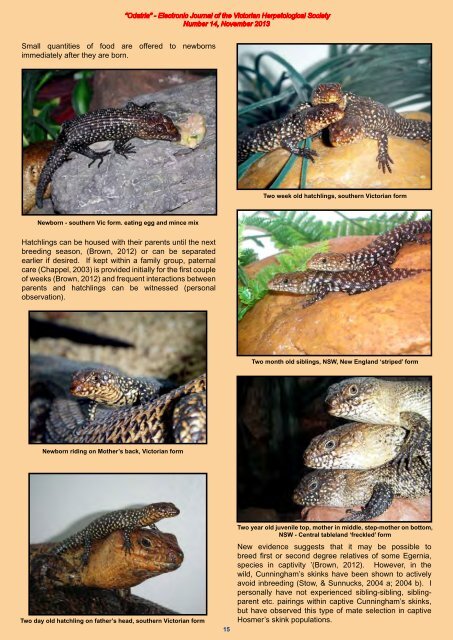winter period. At this time Cunninghams have access tofresh standing water only.After cooling, temperatures return to the normal summerregime and feeding resumes.Generally, within the first week after cooling (particularlyon warm days), mating will occur. Males pursue thefemales in an effort to grasp their necks and positionthem for mating (Brown, 2012). If the female is notready to mate she will run from the male (Brown, 2012;Greenwood, personal communication, 2008) and he mayinadvertently bite and hold on to any part of the femalewhich passes him, including the female’s head, legs,toes or tail (personal observation). Injuries including theloss of digits may result. Side biting can also commonlybe observed, male to female, which may be an attemptby the male to dominate the female and prepare her formating. Shown below is a courtship routine between two(southern <strong>Victorian</strong>) Cunningham skinks which consistedof individuals circling one another and tongue flicking thebase of each other’s tails.Gravid females, or females and their partners, are removedfrom shared enclosures, as other colony members or otherspecies may attack newborns (personal observation). Thegestation period for the Cunningham’s skink is generallybetween 3 and four months (Fyfe, as cited in Swan,2008).Cunningham’s skinks give birth to between two to six liveyoung during summer (Swan and Goodall, 2010; Swan,2008; Stow, Sunnucks, Briscoe, & Gardner, 2001). Theaverage litter size is reported to be four (Swanson, 2007).Hatchings will immediately eat their afterbirth /placenta(Brown, 2012) and should appear active, alert and wellco-ordinated.Newborn - with placenta and part of birth membrane,alongside mother, southern Vic form‘Courtship - sequence’ female left, male on rightNewborn covered with birth-membrane/sac, southern Vic formMale top, female belowFemale top, male below<strong>14</strong>Newborn - southern Vic form, eating placenta
Small quantities of food are offered to newbornsimmediately after they are born.Two week old hatchlings, southern <strong>Victorian</strong> formNewborn - southern Vic form. eating egg and mince mixHatchlings can be housed with their parents until the nextbreeding season, (Brown, 2012) or can be separatedearlier if desired. If kept within a family group, paternalcare (Chappel, 2003) is provided initially for the first coupleof weeks (Brown, 2012) and frequent interactions betweenparents and hatchlings can be witnessed (personalobservation).Two month old siblings, NSW, New England ‘striped’ formNewborn riding on Mother’s back, <strong>Victorian</strong> formTwo day old hatchling on father’s head, southern <strong>Victorian</strong> form15Two year old juvenile top, mother in middle, step-mother on bottom,NSW - Central tableland ‘freckled’ formNew evidence suggests that it may be possible tobreed first or second degree relatives of some Egernia,species in captivity ’(Brown, 2012). However, in thewild, Cunningham’s skinks have been shown to activelyavoid inbreeding (Stow, & Sunnucks, 2004 a; 2004 b). Ipersonally have not experienced sibling-sibling, siblingparentetc. pairings within captive Cunningham’s skinks,but have observed this type of mate selection in captiveHosmer’s skink populations.


